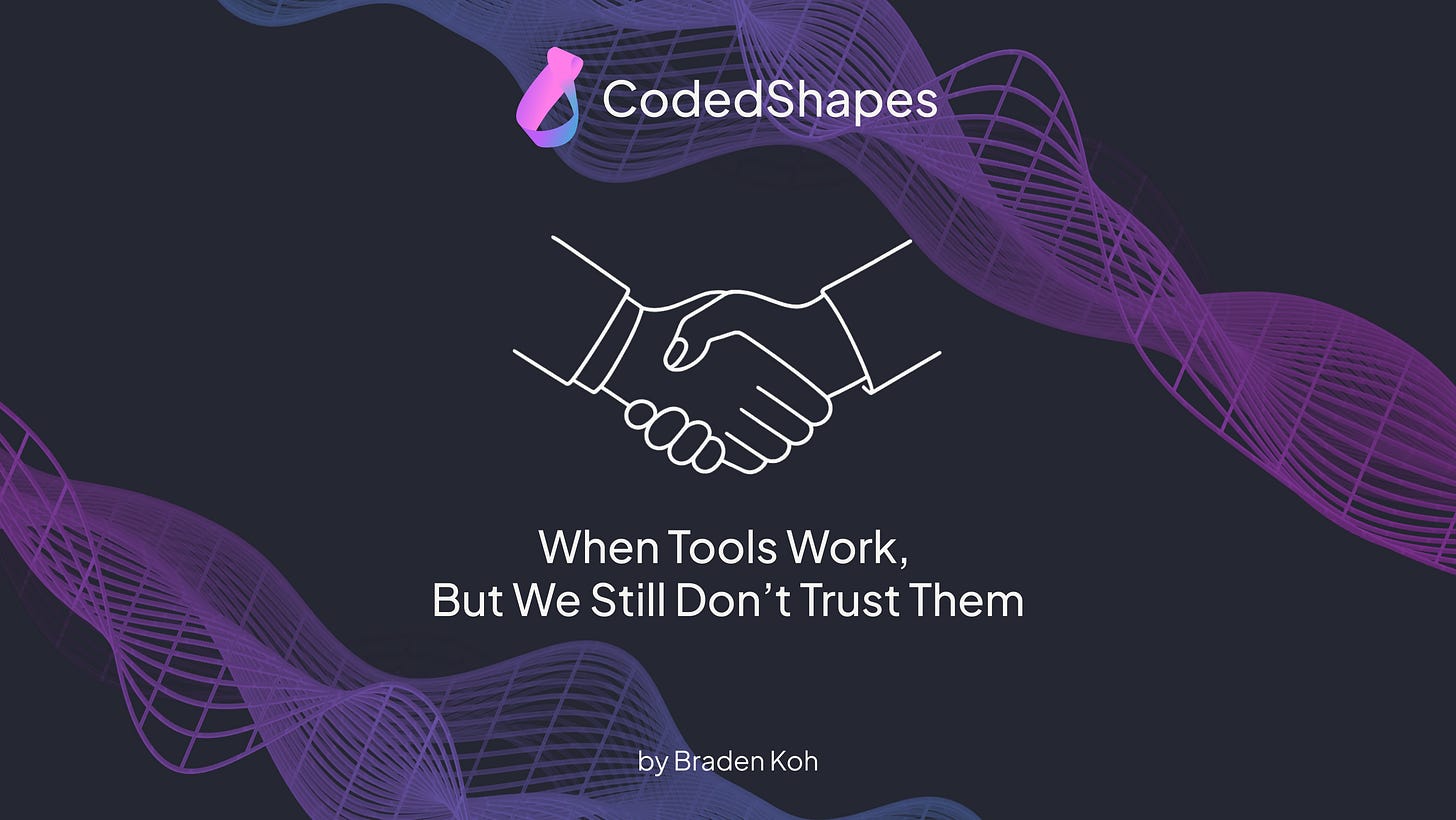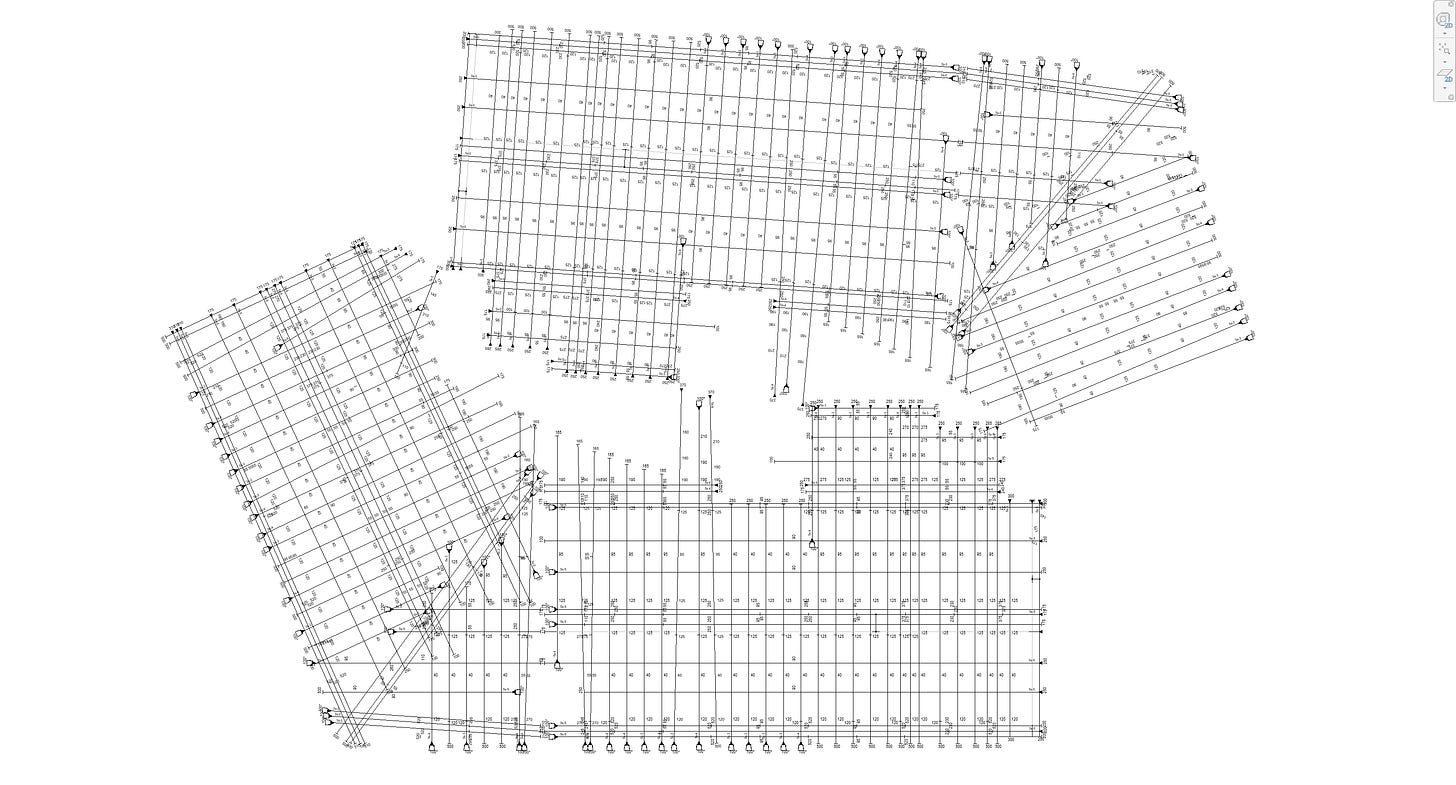When Tools Work, But We Still Don't Trust Them
They help don't they ?
I've been really busy, but I finally managed to squeeze in a coffee with Olivia. A close friend, a drafter and a colleague. Okay, I lied about having coffee. It's 4pm and I'm drinking tea but Olivia is having a flat white though.
We caught up on what’s been happening in our lives over the last few weeks. She'd just come back from Paris. She attended her sister's wedding which was beautiful. And work was the universe's way of balancing out the scales by suffocating her daily.
But you know.... at least traveling and family was good.
Being her friend and a nosy computational person, I asked the reason behind "work is draining her life force from this earth" and maybe I could do something to help.
In turns out, her life has been nothing but Post-Tension (PT) lines in Revit. Olivia has been manually drafting thousands of PT lines on this project. Maybe it was acceptable if it was once-off but the project is still changing. And she has been working nights and weekends just to keep up.
This project has 5 unique floors, at ~4,000 PT elements (tags, dimensions, lines, etc) per floor, which means it's 20,000 PT elements. Imagine drafting all of that manually and then managing the changes manually too. I'd think the universe is against me too.
The worst part? I built a tool that drafted PT automatically from the engineer's design. All the engineer has to do was press a button to upload their designs and the plugin in Revit would take care of the rest. All Olivia would have to do then is clean them up. Then, if a design changed, just repeat that process. Instead of taking days, it would have been hours.
So what is going on here ?
Well, Olivia answered me. Shaun, the lead engineer didn't want drafters to use any automation. He wanted everything drafted manually. "That's how they learn" he said. “If they use the tool, they’ll get lazy and not check things”
Before I could protest more. Olivia had to get back to work. There was more PT to be dratted.
As we got back to the office, I couldn't let it go.
We have a tool, a tool that saves days of work, how can you not want to use it ?
It's not my project but I went to ask Shaun directly.
"Hey Shaun, Olivia tells me that you all aren't using the PT tool I made ?", I asked.
"These drafters are lazy man, they just want the computer to do all the work for them. If they use the tool, it's too quick, they are not going to check their work", Shaun replied.
"Well, whether the computer or a person does it, it still needs to be reviewed. The tool speeds things up but it doesn't change anything. Plus shouldn't the engineer check it?", I said.
"Yes, exactly. If they do it manually, I can walk up to their desk every hour or so and see that things are going well. I can review as they draft."
"That’s crazy, this takes up way more of your time. You can use the tool to get 90% of it drafted and you only need 15 minutes to check it all in one go"
"No, we are not going to use the tool. I need to send them my designs. Why should I do more work just to help the drafters, it's their job."
"But it's just one button. All you have to do, is push one button. Again, you have review the whole thing anyways, why not just speed up the process? This current way of yours seems like it's costs everyone more time"
"No means no. In engineering, everything should be done manually. It's how it's always been. It may be slower, but it's the right way"
There's no getting through to Shaun.
This is how an early version of the tool worked.
I walked away from the conversation but I am not giving up. I am not about to let the project fail because Shaun was too stubborn to use new things. So, at the risk of getting yelled at by Shaun and maybe by the director of that project too, I went snooping.
I found the model on the network drive and sent Olivia the design file. I then told Olivia to use the tool to make her life easier. If Shaun or anyone complains, blame me. Tell them to talk to me and if there is anything wrong, I'll take the responsibility.
And Shaun did exactly that. A few days later, he came marching.
"I said no. How dare you use the tool without my permission? You overstepped.", Shaun "said".
"It's Olivia's right to use any method to get the job done, we have the tool, why not use it ?", I replied
"Well, I am going to comb through every PT she drafted and find for a mistake. That'll show you that using computers isn't as good as doing it manually"
"Go right ahead, you should be doing that regardless if a human or computer did it anyways. This tool has been used on so many projects that it will be stable enough"
Shaun marched off.
Two weeks went by and I haven't heard from Shaun. No yelling or no emails or anything. I half expected a director to come yelling at me.
I did meet Olivia a few more times since then though. She told me that life has gotten a lot better and Shaun is also less stressed. The team is now delivering the PT drafting at quicker pace which has made the client happier and the project in on track again.
So, I went looking for trouble.
"Hey Shaun, haven't heard back from you, what's going on with the project ? How was the tool? ", I asked but I already knew the outcome. Yes, I am being smug about it.
"Hmmm............. it went well……………….", Shaun said
"PT was good. There was no mistakes.... and we made the deadline", Shaun continued after pausing.
"Okay, but that doesn't mean I trust all your tools. This is the exception. I still think we should be doing things manually because that is how it always has been done. But for PT, your tool works well..... and there was no way we could’ve met the deadline without it", Shaun continued again.
Aha, a win. Triumphantly, I might add.
Trust in Computational Design
Trust is hard in computational design. Okay, it's hard in any field but all these talk about AI makes it feel like everyone is onboard with new technology. But the reality is, computational tools often ask people to give up part of a process they’ve always controlled. And that’s hard.
Bringing a script/tool to people who know nothing about computational design is scary. Because if something goes wrong, it’s still their responsibility.
It's why whenever I build tools, I try to involve as many key people as much as possible. The transparency means people understand what it does and it's limitations. Computational design is already abstract and foreign, the last thing you want to do is force people to use it.
Clarity + Stability
So, I try to make the entire process as inviting as possible. I do this by showing people how the solution gets made, documenting the process, holding workshops with samples, so they can use it without the risk of affecting their projects. There's a lot more work that goes into computational design than just making the solutions alone.
Shaun wasn’t entirely wrong here. Not every solution I’ve made is stable. Many of the solutions we make also require a weird ritual. Double click this to run, make sure that toggle is off, there are two files you need....
But if we can get through this hurdle together, we unlock better and faster ways of working.
For me, trust in computational design is about clarity + stability. Make the solution easy to use and understand, involve people in the process, and make sure the tool consistently delivers on the value it promises.
Thank you for reading. Consider subscribing if you haven’t, it really helps me know my writing here is useful.




